

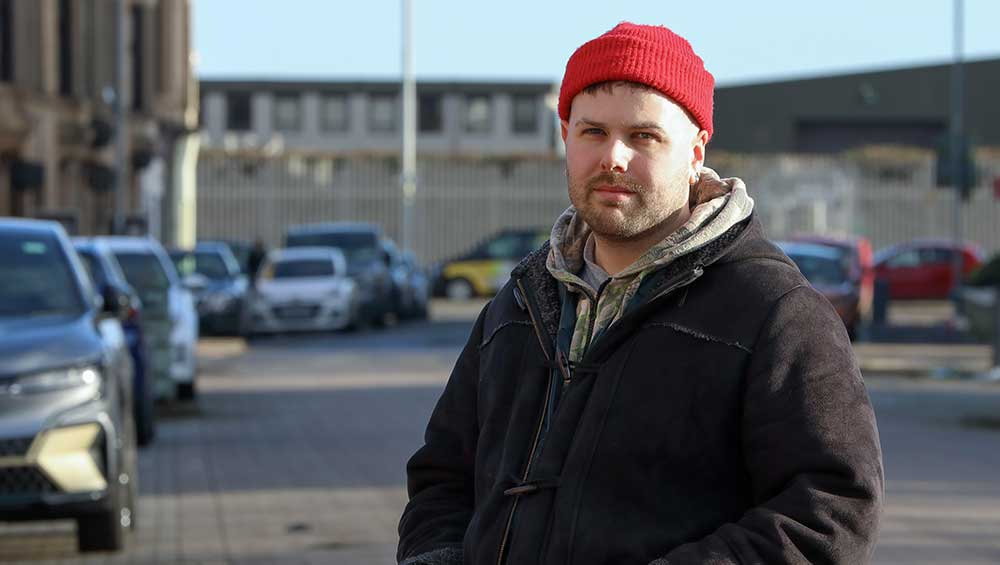
Andrew Black. Photo: Matthew Arthur Williams, 2023.
by VERONICA SIMPSON
“The world is changed.” These words, in scratchy red handwriting, appear at the top of the screen over a tranquil opening scene of trees reflected in water, in Andrew Black’s new film, On Clogger Lane. They are followed, in flickering script, by: “I feel it in the earth, I feel it in the water, I smell it in the air. Much that once was is lost. For none now live who remember it.”
After these profound and arresting lines, Black’s film proceeds, over nearly 60 mesmerising minutes, to unravel the uses and abuses of a very particular landscape, the Washburn Valley in the Yorkshire Dales. The valley is not far from Leeds, where Black was born in 1990 and where the film has opened at The Tetley as part of a solo installation by the artist. The first half of the film lovingly captures this North Yorkshire landscape, from moors to rolling green farmland. In the company of enthusiastic local historians, archaeologists and activists, we learn about Neolithic markings on stones – known as cup and ring markings – as well as witch trials, ghost villages submerged beneath reservoirs, lead mining in the 18th-century and earlier and 21st-century limestone mining. And we learn of the dead children and teenagers whose bones were discovered not long ago in unmarked graves - a legacy of the slave labour of indentured children used in the lead mines in the Victorian era.
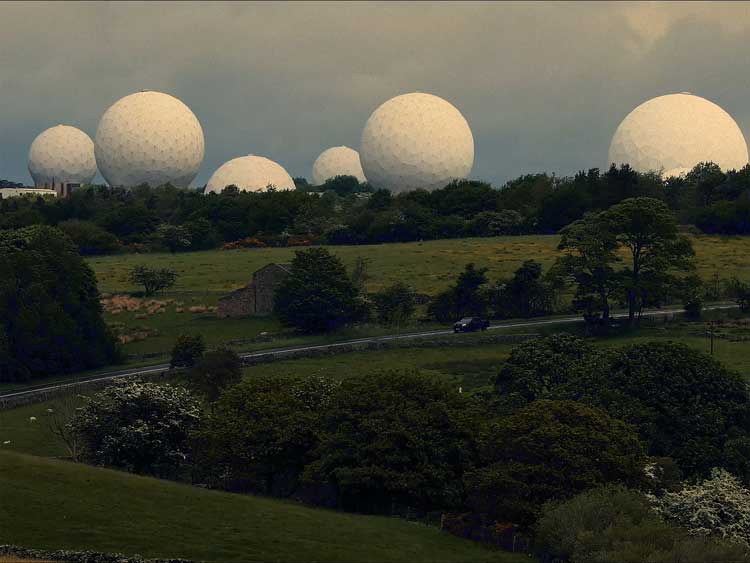
Andrew Black. On Clogger Lane, 2022 (film still). Image courtesy the artist.
This captivating deep dive into the region’s geological, economic and social history leads us to a modern-day monstrosity: Menwith Hill signals intelligence station. Operated by the US National Security Agency and closely guarded, its huge, white satellite listening domes arrived in the middle of the 20th century, without consultation or agreement with the community, where they listen to all the satellite and terrestrial signals around them. We don’t get up close to these vast domes, known locally as “the golf balls”, until well over halfway into the film. By this time, we have met a fascinating group of local people, including some female activists who did protest about their presence. Some are fuelled by Quaker idealism, others by communism, many were participants in the 1980s Greenham Common anti-nuclear protests and brought their peaceful protest tactics to this piece of Yorkshire in the early 90s. Some, now in their 70s and 80s, are activists to this day. One, Lindis Percy, tells us cheerfully that she has been arrested 500 times and expects to be arrested again.
Andrew Black, On Clogger Lane, 2022. Excerpt courtesy of the artist.
The vigour, conviction and wisdom of these women is one of the discoveries in this film. When Black asks Sylvia Boyes, a seasoned protester, if she is angry, she says: “There must be an element of anger and rage, but it is how we use that anger … if we allow it to sort of come out from the top it loses its momentum and … it destroys something within ourselves as well.”
Black, who has lived in Glasgow since 2009, moving there to study at Glasgow School of Art, is not attempting a straightforward documentary, although the conversations with the local groups with whom he spent time from March to August 2022, as well as the clear rapport he developed with them, would be priceless in any standard work of documentary film-making. His artistry is evident in the strange colourings of the film, the collaging of ancient, archive and contemporary images, and the gentle but compelling evolution of the film’s narrative, reinforced by his scenography and the gems of vintage photos and footage he found in the Yorkshire Film Archive. Then there is the hypnotic soundtrack: a mixture of psychedelic thrummings and bangings of cymbals and gongs (much of it provided by Leeds Vibracathedral Orchestra) with medieval songs.
The film came about thanks to Black winning the prestigious Margaret Tait Award in 2021, which is a Lux Scotland commission and Scotland’s most prestigious annual moving image prize for artists, inspired by the Orkney film-maker and poet Margaret Tait. The winning submission, selected from a shortlist, receives £15,000 towards realising their dream project.
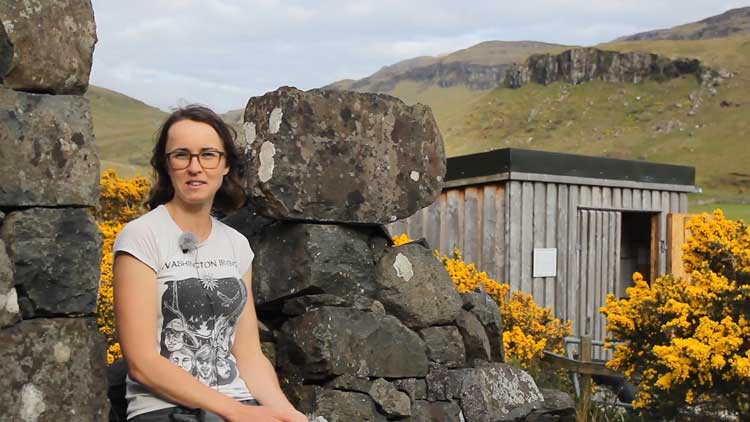
Film still from Dàn Fianais by Andrew Black shows Skye crofter Cheryl McIntyre. Image courtesy the artist.
Previously, Black completed a commission with Atlas Arts, Dàn Flanais (2021), as part of the Plural Futures Community Film project on the Isle of Skye, which was shown with Aman Sandhu at the Glasgow international festival in June 2021. Black’s work was also exhibited last September at Centre Clark, Montreal, as part of The Magic Roundabout and the Naked Man with Aman Sandhu (2021). Solo exhibitions of his work include: Eternity Knocker, at the Centre for Contemporary Arts in Glasgow, in 2019; Submerged Village, at the Market Gallery in Glasgow, in 2017; and Our Andrew of the Flowers, at the Embassy Gallery in Edinburgh in 2016. Group exhibitions include: Seized by the Left Hand, at Dundee Contemporary Arts in 2020; and Class Trip, at Casino Luxembourg, in 2018.
Black spoke with Studio International at the Tetley in Leeds before the show’s opening.
Veronica Simpson: The focus of your film, although I like that we don’t see them up close until well over halfway through, is the huge white surveillance domes operated by the US Department of Defense on Menwith Hill.
Andrew Black: I grew up seeing them regularly in my childhood. I grew up very nearby. They dominated the entire landscape. Everyone just calls them “the golf balls”. You’re so desensitised to them.
VS: Along with these domes, we also get insights into the long history of local activism and protest. How much of this did you know about before you started your research?
AB: When I was a teenager, I had no idea there was anything like that degree of protest. I knew there had been protests there, but not the political context, or that it was a women’s protest.
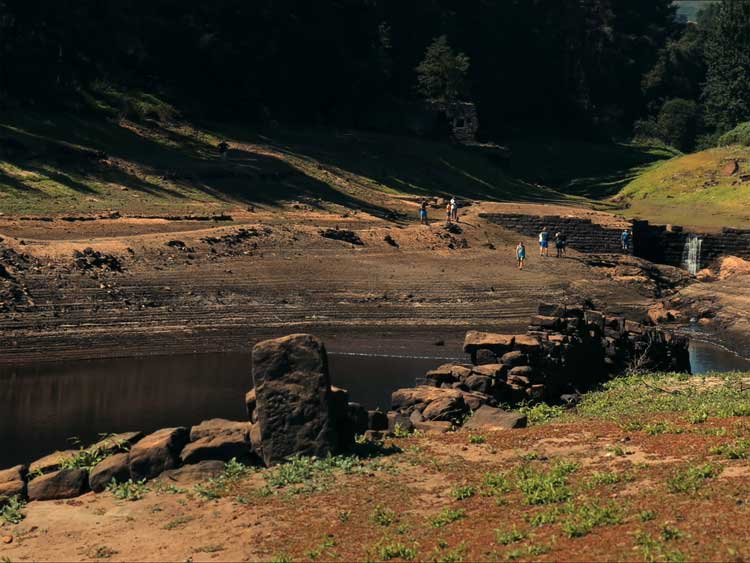
Andrew Black. On Clogger Lane, 2022 (film still). Image courtesy the artist.
VS: I like that the film leads us into these acts of resistance very slowly – after taking us on a time-travelling trip starting with older and benign forms of land usage, then contrasting that with examples of massive, industrial exploitation of the land around here, over hundreds, even thousands of years.
AB: I couldn’t make a documentary just about the golf balls because there’s no way you can unless you’re an investigative journalist and you’re willing to put yourself up for quite a lot of scrutiny. Something that’s interesting to me in my practice is social history, oral histories and people’s histories. I wanted to navigate it that way, through the experiences of people who had protested against it.
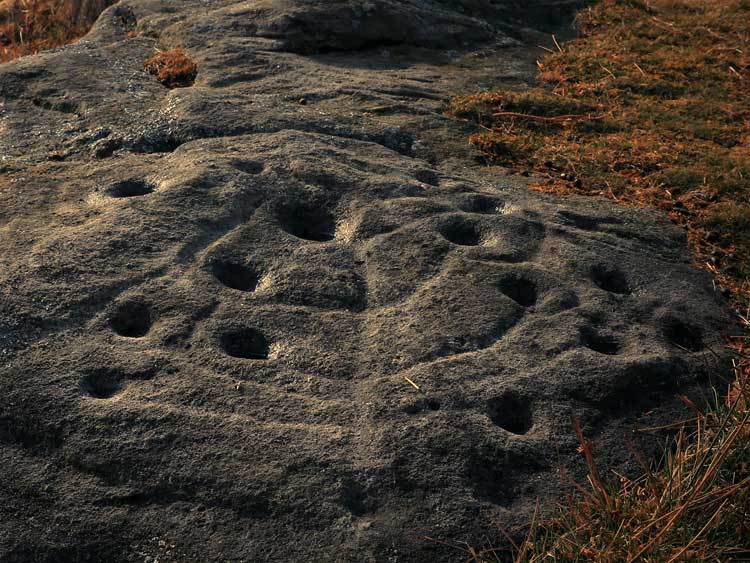
Andrew Black. On Clogger Lane, 2022 (film still). Image courtesy the artist.
VS: The film delves into the rich folk history of the area, which also ties in with the ancient symbols your archaeologists are investigating at the beginning.
AB: They’re neolithic, possibly bronze age. This valley just has this absolute saturation of intense presences. On the surface, it’s a plain agricultural landscape. But it’s a concentrated site for these cup and ring markings. They’re more concentrated there than most other places in the British Isles. I don’t know why; it must be something about the topography. It’s on the edge of the Dales, which have always been strategic. In Roman times, there was lead mining here. It has always been an important part of the north, going back further than we can know. But now it’s very rural. I was trying to point to the fact that … the English countryside has always been a site of contest. It’s not just gentle and conservative.
VS: The soundtrack is so atmospheric, especially the beautifully simple, pure, medieval-sounding songs. Where did you find them and why did you use them?
AB: I just stumbled across those songs. I think they’re so theatrical, so English. Some of them are Elizabethan, some are 12th and 13th century. The one that ends the film (Ja Nuns Hons Pris, 1194) was written in prison by Richard the Lionheart (Richard I of England) after returning from the crusades. Another song, The Foweles in the Frith, is, I think, the earliest piece of English music that was notated.
Why use them? All those lyrics in the songs are about sorrow, about being imprisoned. That’s a subtext for the film, from some of the women’s actions at the base, and the witches who were taken to York. Another song is about the desolate landscapes where you feel grief. Some of them are very over the top, emotional, there’s a melancholic feel to it.
The versions of the songs that you hear are entirely synthesised, there’s no real instrumentation or voice. I like that digital clashing with the ancient kind of thing. The other music I should mention is a Leeds band called Vibracathedral Orchestra. They have made quite psychedelic improvisations. My A-level art teacher is in that band. I liked their sound, I wanted to record something new with them.
There’s something about the way that the whole film evolved, which came from just speaking to one person and them saying you should go and speak to him or her, and just navigating it that way. I’m not wanting to make an argument of it.
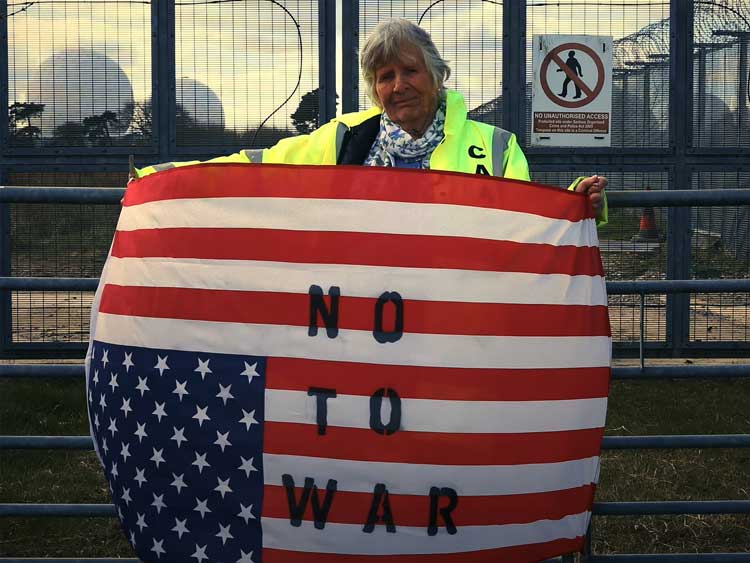
Andrew Black. On Clogger Lane, 2022 (film still). Image courtesy the artist.
VS: It does feel very conversational, with issues growing organically. There was a great moment when – only in subtitles, we didn’t get your voices – you asked if there was some kind of energetic charge here, to justify why so much has happened in this valley.
AB: It’s when I was interviewing Stephanie Shields, who is a farmer, very traditional. She wrote a novel, The Strange Woman, about the women from her village accused of witchcraft. I spoke to her and, after a while, it became apparent that she definitely had a sympathy with some other things that are intangible, that you can’t put your finger on, that are in the landscape. You experience time and different eras of time compressed into the same space. I wanted to get into that. She does dowsing, water divining. She’s very conscious of these other qualities in the land.
VS: There is an inference that the reason the US wanted its satellites here is because there is some extra energetic charge to the place. Did you talk to the base at all?
AB: No, it’s actually terrifying when you get close to it. I went there with Lindis [Percy]. As you drive up near it, a car tails you immediately. As soon as you get out, they pull out a machine gun. They’re filming you as you speak to them – I had my mask on, it was Covid – but there was no way I wanted my face on camera. There was no way of engaging them at all.
VS: The domes look innocent enough to start with, though – almost playful. Then the more you see them and understand what they’re about, the weirder and more menacing they get.
AB: You see them from everywhere, from miles and miles around. For such a secretive place, it’s so visible.
VS: There’s a lush, analogue quality to the colouring of the film, it’s very Kodachrome, it feels very last century.
AB: I had much more extreme ideas for the colour initially. There’s an editor in Glasgow called Jen Martin, who was showing me things we could do, trying to match them to photographs that were in one of the local archives, in the Nidderdale Museum. Over the years, the photos in the display had bleached in the sunshine to the point where the black had gone orange. I wanted to make all the shadows bright orange. It looked amazing. But it might have been too much to have the whole film like that. I worked with another editor, trying to get it slightly artificial. There’s a blue tone to the shadows sometimes. It tells you that it’s digital film. You can see the pixel structure of the images. But I wanted it to have a slightly psychedelic, hallucinatory feeling, not to be too bucolic and pretty and documentary. Not too visually similar to the lifestyle and leisure industry documentaries.
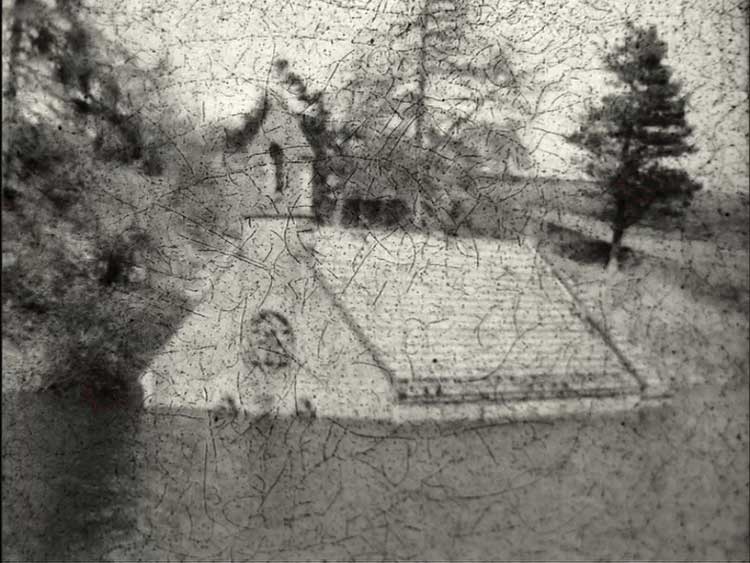
Andrew Black. On Clogger Lane, 2022 (film still). Image courtesy the artist.
VS: I guess you had to keep us rooted to an extent in the real and the here and now, to remind us that this invasive presence is still very much here, and that protest is possible.
AB: One of my questions going in to making the film was: “Why has this stopped?” That spirit of protest was so lively, so good natured, and built on friendship and community. It was slightly anarchic, but very meaningful relationships were made. Where did it all go?
VS: It was fascinating that all those women who protested in the 80s and 90s are still around locally.
AB: Yes, and still protesting. I think protest is an extremely loaded topic right now, because it’s about to become illegal. And if it does, we are slipping into fascism. And we need to name that. It sounds extreme. I don’t know if I want to agitate people.
If there’s a piece of work that adds to an archive of how this well- known area of the Yorkshire countryside has been betrayed … it’s an important piece of social history that’s happened here. And they are local women. There’s a stereotype of people in rural England as being very conservative. Well, a lot of them are. But I wanted to disturb that idea and not have radical ideas associated only with metropolitan or cosmopolitan communities. It has a long pedigree in rural communities too.
This film comes right off the back of a project I did in Skye, with Atlas Arts. It’s a community video. It’s less of an abstract piece of work, more of an inspirational work around a question, commissioned by a group called Skye Climate Action, who wanted to speak about what it meant in the West Highlands, what people’s way of life can do to speak to that issue.
It turned into a much deeper set of enquiries. It was taking an opportunity to look at how capitalism has transformed that landscape and its community, because you can trace it so clearly. For example, with the clearances, the people who did the clearing had profited from the slave trade, and most of the money they used to buy up the land, which they then used for sheep farms, came from the compensation payments after its abolition. An academic called Iain MacKinnon, who lives in Skye, has written a big research paper on this. He’s drawn links between families who still own that land.
There’s a backbone to the film looking at what life in the Hebrides was like. It was much more transhumance. Before crofting was imposed, people rotated their grazing and planting throughout the township year by year, so everyone had a fair share of poor and good ground. And it was a very productive landscape. But it wasn’t about turning a profit: for centuries, it was sufficient to their needs, supporting traditional language and music. All of that was violated. And that’s what we’re living with the aftermath of now. Now it’s facing another level of economic attack because it’s becoming so popular with Airbnb and Instagram. Housing is being bought up – cheaply, for someone who lives in England - so locals can’t afford it and it’s turning into a holiday park.
Two people influenced quite a bit of this film and the work in Skye, both academics, both from Skye. One is MacKinnon. The other is James Oliver, who lives in Australia but is from Skye originally. James challenged me to this idea that there’s this phrase in Gallic which is untranslatable and revolves around this idea of belonging – belonging based on your ancestry and also your relationship with your community and your stewardship of a piece of land, and it’s about being deeply emplaced there. I think it has resonances in Indigenous cultures, first nations people. Dúchas is one of the versions of the word. I think a lot about rootedness in rural places, as an important thing.
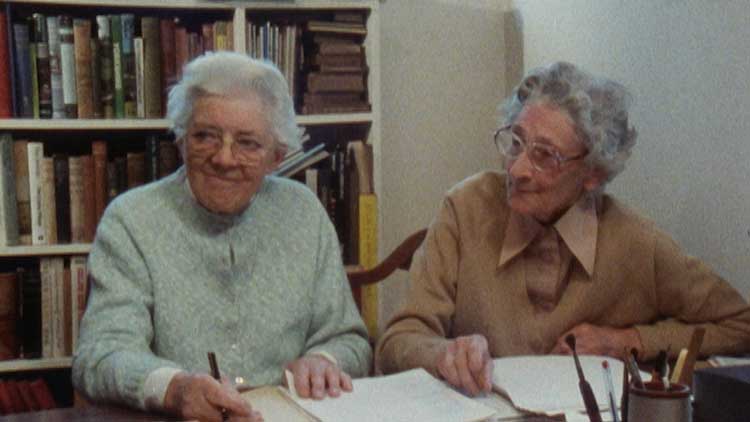
Andrew Black. Eternity Knocker (film still). Image courtesy the artist.
Before the Skye film, I made a film, Eternity Knocker, in Swaledale in the Yorkshire Dales with some farmers, all from families going back to the 1200s or something. The family name is only found there. It’s so deep. Could you describe them as having a form of duchas? I think it comes from a set of cultural practices that have resisted industrialisation and capitalism to some extent, and imperialism or colonialism.
VS: What’s your next project?
AB: I don’t know what comes next. After being up in the Highlands, where everything felt so energised, coming back to the real Tory heartland of North Yorkshire felt very counterintuitive. But then I met these people who are committed Quakers and communists.
The film-making process for me is a research process first, an ongoing research process, and the film is what it forms into when it’s ready, when different aspects of that research are ready to speak to each other. And that research is still ongoing. A lot has been gathered over the last three or four years - in Skye, in the Dales. I’d like to start putting (these projects) into conversation with each other.
When I asked Silvia Boyes whether she does this from a place of anger, whether it is fire-fighting or a vision for a better world, she said there must be some element of anger but it’s how you use it. She’s a Quaker. For her, it’s a very spiritual thing. We all have a responsibility.
VS: It was amazing that you found a 1990s clip of her protesting about the Menwith Hill surveillance station as a young woman. What was it she said?
AB: She said: “Is the earth really ours to do as we want with? Surely, it’s held in trust? We hold it in trust for future generations.” It’s not bringing a new vision out of nowhere, it’s saying I am from Yorkshire, I do care about this very conservative landscape. How can we try and envision how this place could still have its identity but not be burdened by these really regressive ideas?
• Andrew Black’s film On Clogger Lane premiered at the Glasgow Film Theatre on Tuesday 21 February 2023. The film is also screening, along with an installation of archive and contributory material, at the Tetley, Leeds, until 14 May 2023.